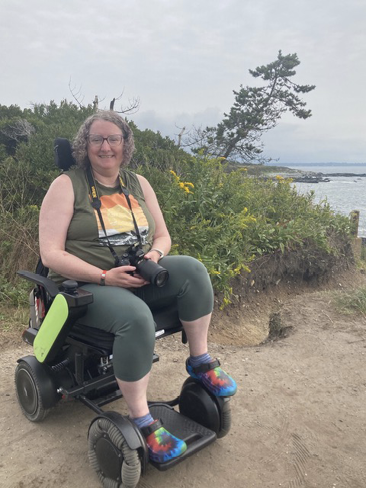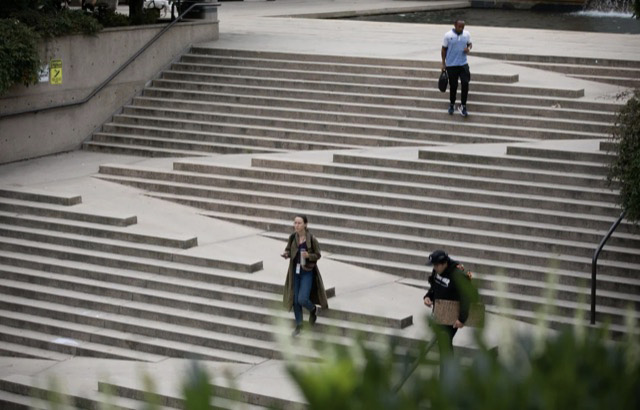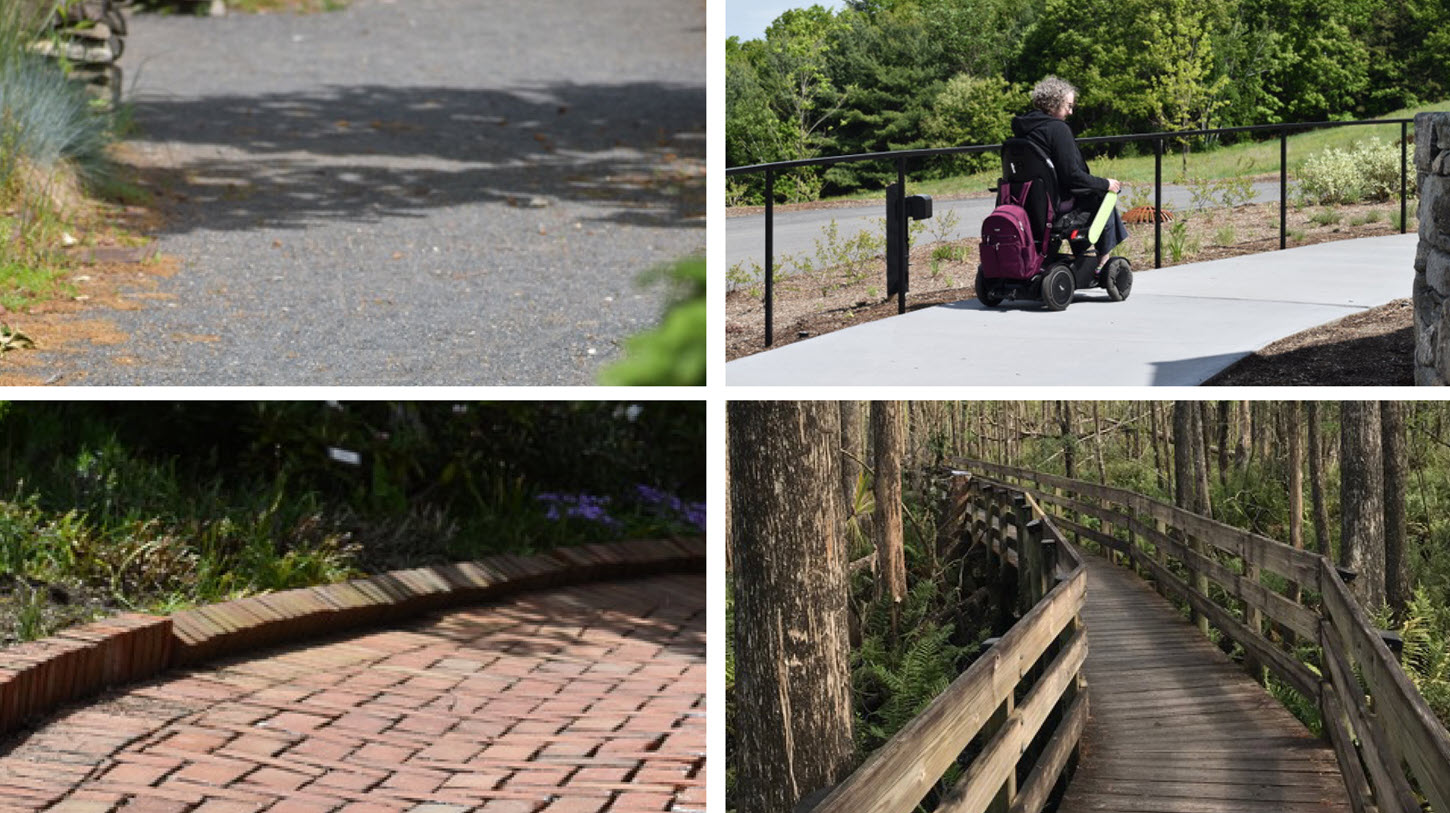Heather Finlay-Morreale

Heather, wheelchair birding. Photograph by Richard Morreale.
Birds have delighted me since age 14 when I began volunteering at a wild animal hospital. I always loved animals, but I became captivated by the birds I encountered there. I flipped through bird guides, from color photo to color photo, dreaming of adventures with tanagers and buntings.
As an adult, I transmitted birding fervor to my husband, and we often hiked. On our honeymoon in Hawaii, we searched high and low for a Nene by foot and by car. When we chose trails, we rarely considered trail lengths or difficulty. We simply chose the most interesting-sounding trail.
Ten years ago, on a hike in Kentucky, my lifelong but until then manageable foot pain became intolerable. Each step was agony. For the next few years, I limped along, only painfully doing short trails. This was later explained when I was diagnosed with an autoimmune neurological condition. It was now impossible for me to walk trails. I delighted in watching the birds at our feeder, but I thought my outdoor birding days were over.
Then a friend lent me a manual wheelchair (one propelled by the user’s arms or pushed by another person). I was excited to leave the house for some favorite outings. This was the experience I needed to push me over into the world of wheelchair users. I am an ambulatory wheelchair user, meaning that I can walk, but not far or well, and use a wheelchair part-time. I am not “wheelchair-bound,” but rather freed from being housebound. With a wheelchair I hoped I could bird again.
We traveled to Florida that winter. In Florida, due to the high water level in the rainy season, most large bird sanctuaries and nature trails have wheelchair-accessible boardwalks. The only accessibility issue I ever had was that the trails were so popular that sometimes it was challenging when two wheelchair users had to pass each other. In Florida, my husband and I wheeled our way through sanctuaries and saw Pine and Black-and-white warblers, vireos, ibises, herons, egrets, a Northern Parula, and woodpeckers. On that trip, my childhood dream was achieved—I saw a Painted Bunting. I was now an avid wheelchair birder. At least in Florida.

Figure 1. Legally “accessible,” but not actually accessible, entrance to a public building in Vancouver, Canada. Note the lack of handrails or raised edges on the ramp so that a wheelchair user can easily roll off ramp and land face-first on the concrete steps. Also, note the steep grade. (Photo credit: https://www.cbc.ca/news/canada/british-columbia/robson-square-accessibility-1.5255477).
When we returned to Massachusetts, we tried a trail promoted as “accessible for all.” Spoiler alert, it was not accessible. The short boardwalk portion was, but to get there we had to go down a steep slope. In other spots, the wheelchair sank an inch or two into the ground. Wheelchairs are heavy, with a manual one weighing about 35 pounds plus the person’s weight. It takes momentum to get one moving. It takes even more force to get it going uphill. Power chairs are even heavier. I have one of the lightest power chairs on the market, only scooter-sized, and it weighs 125 pounds. This is simply too heavy to carry over a large puddle of unknown depth or over a large root or stretch of sand. It was impossible to traverse this “accessible” trail and I had to get out and walk. I could do that, but many wheelchair users could not. If I could not navigate the best local all-accessible trail, I did not want to drive even farther away to be disappointed again. I was crushed. Outdoor birding was still inaccessible.
A year later, I met a nature-loving family from Portugal at a wheelchair store, with their wheelchair-using teen. They reported similar experiences on local accessible trails to which they were directed. Even with their daughter’s rugged power wheelchair, the trails were impassable. For a trail to be accessible, ALL stretches of it need to be accessible. Somehow, this is commonly overlooked.
 Top Left. Packed dirt over gravel surface is accessible for manual and power wheelchairs. Photograph by Heather Finlay-Morreale. Top Right. An accessible paved path with slow grade and a handrail for those who walk but need support. Photograph by Richard Morreale. Bottom Left. This paved brick path has gaps small enough so that a wheelchair wheel does not get stuck. Even with undulations, it is passable for many. Photograph by Heather Finlay-Morreale. Bottom Right. A boardwalk in Florida. Photograph by Heather Finlay-Morreale.
Top Left. Packed dirt over gravel surface is accessible for manual and power wheelchairs. Photograph by Heather Finlay-Morreale. Top Right. An accessible paved path with slow grade and a handrail for those who walk but need support. Photograph by Richard Morreale. Bottom Left. This paved brick path has gaps small enough so that a wheelchair wheel does not get stuck. Even with undulations, it is passable for many. Photograph by Heather Finlay-Morreale. Bottom Right. A boardwalk in Florida. Photograph by Heather Finlay-Morreale.
New England has challenges, as does Florida, in making trails accessible. How can local trail designers make truly accessible trails? First, start with the Americans with Disabilities Act (ADA) guidelines, but do not stop there. Strictly using a rule book can go awry. A park near me remodeled, and they moved disabled parking from the top of the hill near the entrance, to way down the hill with a winding uphill spiral path to the entrance. When I called the accessibility staff, they said it met the ADA rules so therefore must be suitable. The reality is that a design can meet legal or ADA guidelines and still be an accessibility failure. Figure 1 is an extreme example of this at the entrance of a public building in Vancouver, where Canadian guidelines were met but the entrance is still not functionally accessible (https://www.cbc.ca/news/canada/british-columbia/robson-square-accessibility-1.5255477).
In contrast, some design wins that I have seen are flat-packed, dirt-covered with very thin grit, or paved trails without large roots or other barriers (see photos above). This is much more navigable than totally impassable pea-sized or larger gravel trails. Well-done brick paths can also be navigable for wheelchairs but may be less so for unsteady walkers who could trip. Boardwalks for an entire trail would be a fantastically accessible feature.
Inviting disabled people, those with lived experience trying to bird in a chair, to design accessible trails will result in more success stories. The disability civil rights movement has a rally cry of “Nothing for us, without us.” We need to be at the design table for trail upgrades and designs for new trails. Only then will things go from almost accessible to truly accessible and wheelchair birders will have access.
Heather Finlay-Morreale, MD, is a birder, physician, patient, writer, artist, and assistant professor of pediatrics at UMass Chan Medical School. She is active in disability-related advocacy and education. She resides in Shrewsbury, Massachusetts, and is an ambulatory wheelchair user.